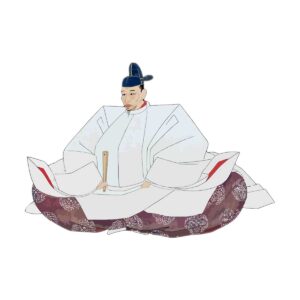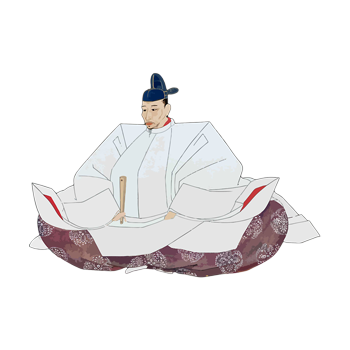
Samurai leader who seized control of the Momoyama government. Nicknamed Toyotomi Hideyoshi, he was first a member of the Kinoshita clan, and later changed his name to Hashiba and then to Toyotomi. He was called Toyotomi Hideyoshi (Toyotomi Hideyoshi). He was born in Owari Province (Aichi Prefecture), served under Nobunaga for many years, and distinguished himself through his military exploits with his talent and agility, defeating Akechi Mitsuhide at Yamazaki in the Honnoji Incident in June 1582 and paving the way for his seizure of power. 1583 he built Osaka Castle; 1585 he was promoted to the first rank of Kanpaku, and 1586 to Grand Minister of State, In 1592, he went to war against Korea, and in 1597, he returned to Japan. Hideyoshi was a great admirer of waka poetry, renga, and Noh drama as well as military arts, and he especially enjoyed the tea ceremony. In 1576, he received a large scroll painting from Nobunaga for his work in building the castle at Azuchi, and in December of the same year, he was given the famous kettle “Otogozen” during his conquest of Tajima and Harima. After Mitsuhide’s defeat in 1582, he held tea ceremonies at Honkokuji Temple on July 2, at Yamazaki Castle on November 7 and at Sakamoto Castle on January 5, 1583, and at Osaka Castle in June, followed by a series of tea ceremonies in early July, In January 1584, he held a tea ceremony in Yamasanomaru, and in January 1585, he went to Arima Onsen, and in March of the same year, he created eleven tea ceremony rooms at Souminin in the Daitokuji Temple, inviting 143 samurai and commoners. In March of the same year, Hideyoshi created ten Kakecha-ya-style seats at Somiin Temple in the mountains of Daitokuji Temple and invited 143 people, including the tea masters Munehisa Imai, Munenori Tsuda, and Soyoshi Sen, who had been Nobunaga’s tea masters, at his disposal. In October of the same year, he presented tea to Emperor Shojincho at the Imperial Palace, where he moved the golden tea ceremony room he had built in the Osaka Castle Honmaru. In January 1587, he held another grand tea ceremony at Osaka Castle, followed by the famous Kitano Grand Tea Ceremony on October 1 of the same year. The tea ceremony was held at the famous Kitano Grand Tea Ceremony on the same day, with a sign on the front of the event stating, “If you have any interest in the Japanese rituals, you may attend from anywhere in the world, In 1590, he went to Odawara, and on February 28, 1591, he died in the battle of Odawara, and in April 1592, to command the army to conquer Korea, he rode his horse to Nagoya in Hizen Province (Chinzei Town, Higashimatsuura County, Saga Prefecture), where he also held a tea ceremony in a mountain village and invited many generals. In 1594, he moved to Fushimi Castle, where he again established Yamasatomaru, a tea house and a study center. The tea ceremony room and study hall were established, and according to Seisho Seung-jae’s notes, “There is a teahouse and a fireplace, a place where one can enjoy oneself as one desires. In his later years, on March 15, 1598, he held a cherry-blossom viewing party in Daigo, and had eight teahouses set up for the event. On the one hand, Hideyoshi’s tea ceremony was a golden tea befitting the golden and brilliant power that brought the Momoyama Period to life, and a tea ceremony to show off his “tools” as a symbol of his power, and on the other hand, it was a tea ceremony for amusement in the teahouse style that reflected his unique sense of the common people, and on the other hand, it was a tea ceremony in the Rikyu style as a standard for “culture and learning. On the other hand, Wabicha of Rikyu’s style was a standard of “culture and learning.” Hideyoshi’s tea was the unification of these three aspects with his agile political sense. However, Hideyoshi was influenced by Fukan Rikyu in his ideals of tea, and he himself wrote, “It is known that the tea ceremony is only when one understands the heart of the deceased,” and in his “Shoin Fuwa Teisho,” he strictly prescribed the Wabi-style tea ceremony of one soup and three dishes. After Rikyu’s death, he remembered Rikyu’s tea ceremony in every occasion. We can see Hideyoshi’s humanistic and open attitude toward tea in his “Sotan Diary” and other writings. It is said that Hideyoshi did not like the “black color” of Rikyu’s Raku tea bowls, which eventually led to the appearance of Furuta Oribe and Shino ware and Oribe ware, which were in line with the times. Hideyoshi, no less than Nobunaga, protected and encouraged the pottery industry, and there is already a certificate of control issued to Ibe Village in Bizen Province (Ibe, Bizen Town, Waki County, Okayama Prefecture). The Japanese ceramic industry under Hideyoshi was also able to make a major breakthrough during the Hideyoshi period, as many new domestic kilns were established by Joseon potters during the Bunroku and Keicho Periods (1592-8).


